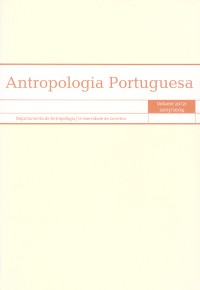Please use this identifier to cite or link to this item:
https://hdl.handle.net/10316.2/29377| Title: | Oral tori in a sample of the spanish university students: prevalence and morphology | Authors: | Galera, Virginia Moreno, Josefa María Gutiérrez, Esperanza |
Keywords: | Torus palatinus;torus mandibularis;torus maxillaris;Spanish population;Torus palatinus;torus mandibularis;torus maxillaris;população espanhola | Issue Date: | 2004 | Publisher: | CIAS - Centro de Investigação em Antropologia e Saúde | Abstract: | Oral tori are an enlargement of the osseous tissue in different parts of
the upper and lower maxillaries. Oral tori were studied in a Spanish sample of
278 university students, from both sexes, and age between 18 and 39 years. Presence
or absence and morphological variability (analysis of their location, degree
of development, form, and symmetry) of the oral tori were the topics of this
research. A high prevalence with no sexual dimorphism was found for the three
oral tori in the Spanish student population (torus palatinus 44.3%, torus maxillaris
50.7%, torus mandibularis 54.7%). Only 20.3% of the individuals had all
the three tori. The torus palatinus was well developed in 52.9% of the individuals;
it had a non-lobular form, and its more frequent location was in the middle
or middle-posterior palate. The torus maxillaris was symmetric with respect to
both sides of the maxilla, and asymmetric with respect to the buccal and lingual
surfaces on the same side. All showed simple form on the buccal surface, and
multiple on the lingual one. The location was middle-posterior on the buccal
surface, and posterior on the lingual one. The torus mandibularis was symmetric,
and had the greater degree of expression. In all the cases, the location was middle,
and the most frequent form was multiple. The analysis of the world distribution of
the prevalence leads us to reject the traditional notion that the oral tori occur with
more frequency in populations from the Arctic and Sub-arctic regions, and to support
the idea of the genetic origin as the main factor for the etiology of these tori. Os tori orais são espessamentos do tecido ósseo que ocorre em diferentes partes do maxilar e da mandíbula. Estes caracteres discretos foram estudados em 278 estudantes universitários espanhóis, de ambos os sexos, com idades compreendidas entre os 18 e os 39 anos. Os tópicos da investigação foram o estudo da sua presença ou ausência e da variabilidade morfológica (análise da localização, do grau de desenvolvimento, da forma e da simetria). Na amostra não foi encontrado dimorfismo sexual nos três tori orais estudados (torus palatinus 44.3%, torus maxillaris 50.7%, torus mandibularis 54.7%). Somente 20,3% dos indivíduos apresentavam todos os tori. O torus palatinus encontrava-se bem desenvolvido em 52,9% dos indivíduos e tinha uma forma não lobular, sendo mais frequente na parte média ou na média-posterior do palato. O torus maxillaris era simétrico no maxilar e assimétrico nas superfícies bucal e lingual do mesmo lado. Todos mostraram uma forma simples na superfície bucal e múltipla na lingual. A sua localização era média-posterior na superfície bucal e posterior na lingual. Quanto ao torus mandibularis apresentava-se simétrico e com elevado grau de desenvolvimento. Em todos os casos tinha localização medial e a forma múltipla era a mais frequente. A análise da distribuição mundial relativamente à sua prevalência leva-nos a rejeitar a hipótese tradicional de que os tori orais ocorrem com maior frequência nas populações das regiões árticas e subárticas mas corroboram a hipótese de uma origem genética como factor mais importante para a sua etiologia. |
URI: | https://hdl.handle.net/10316.2/29377 | ISSN: | 2182-7982 | Rights: | open access |
| Appears in Collections: | Antropologia Portuguesa |
Files in This Item:
| File | Description | Size | Format | |
|---|---|---|---|---|
| ap20-21_artigo13.pdf | 814.68 kB | Adobe PDF |  |
Items in DSpace are protected by copyright, with all rights reserved, unless otherwise indicated.
